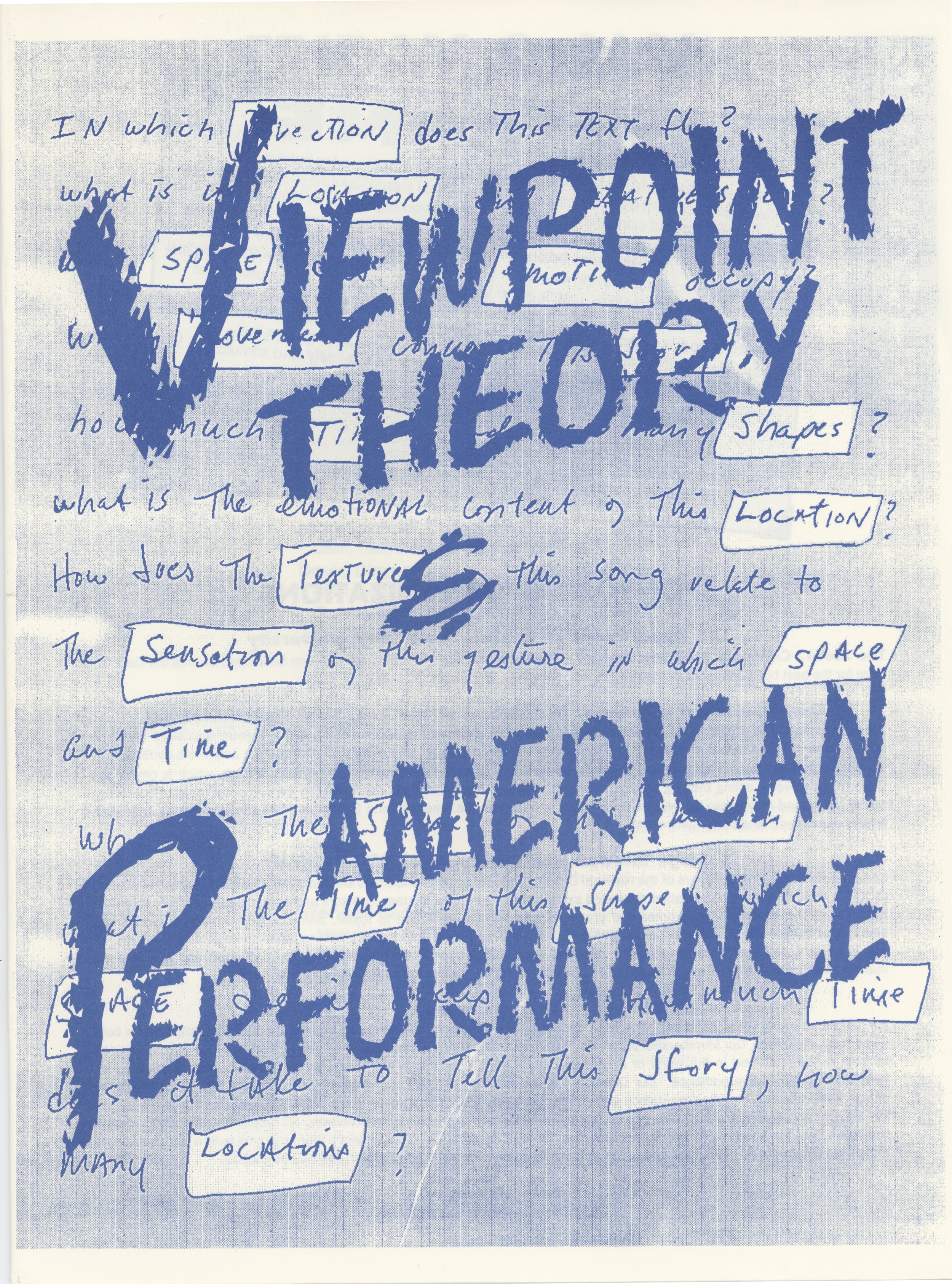The Viewpoints
I first met a way of moving in space integrating improvisation with composition, which relied on perception and response as a basis of expression, in the winter of 1976, in a workshop taught jointly by Mary Overlie, Cynthia Hedstrom and Judy Padow, members of The Natural History of The American Dancer (Lesser Known Species). They were facilitating ensemble and solo improvisation based on identifying the field of perception and practicing direct in-kind-whole-body response. This direct relationship to perception coupled with a practice of uncomplicated direct response resulted in intimate, of-the- moment coherence. Meaning, rather than being fabricated, simply occurred. This could happen between oneself and one’s perceptions, or between two movers, or any number of moving bodies and minds which might constitute an ensemble.
In retrospect this type of improvisation, dubbed “Contemporary American Improvisation” much later by Barbara Dilley, one of the founders of The Natural History and a member of The Grand Union and The Judson Dance Theater, was in direct relationship to Anna Halperin’s earlier work, the Judson Dance Theater explorations instigated by Robert Dunn, and the pure thought of John Cage. Mary Overlie, in my experience, took a next step, collating and systematizing this type of improvising and composing process into a type of Ur-technique which she called The Viewpoints. She pithily, and with a great deal of certainty, offered 6 labels to bring our field of perception into consciousness: space, time, shape, movement, story and emotion. This urge to create a pedagogy was accelerated by Mary being hired (fall 1977) as the first independent artist—not a member of the experimental theater companies—to be hired by Ron Argelander, the founder of the Experimental Theater Wing (ETW), a newly formed studio inside Tisch School of The Arts at NYU. Mary taught her way of making performance, and dancing to the first cohort of ETW students and she relied on the formulation of The Viewpoints to do this. I followed Mary into ETW the following year by means of substituting for her an entire semester during her recovery from serious illness. Week by week over the semester Mary dictated to me what became a Viewpoints Curriculum. I wrote these things down and delivered them to my first class at ETW. The history of the development of The Viewpoints at ETW and in Mary’s choreography and in my own teaching is available in the documents and media below.
-
Viewpoints Pedagogy & Practice: 5 Zoom lectures Jan - March 2022
Transcription of Day 3 Viewpoints Pedagogy Notes by Jeri Preston
Mary Overlie Naropa University Lecture - Jan 23 2019
-
Beavers, Wendell. “The Soul of the American Actor Meets Mary Overlie: Original Dance Anarchist and Post-Modern Evangelist: A Tribute to Mary Overlie 1946-2020.”The Soul of the American Actor.
Drukman, Steven. “Entering the Postmodern Studio: Viewpoint Theory.”American Theatre, vol. 15, no. 1, Jan. 1998, pp. 30–34.
Kuhlke, Kevin. “Mary Overlie: Absence and Presence.”American Theatre, 17 June 2020.
Perucci, Tony. “Mary Overlie: 1946–2020.” TDR: The Drama Review, vol. 65, no. 1, Mar. 2021, pp. 12–14.
Shteir, Rachel. “THEATER; Dispensing With Dogma In the Education of Actors.” The New York Times, 2 Aug. 1998.
thINKingDANCE. Wendell Beavers Interview by Miryam Coppersmith, Philadelphia based online publication. 5/14/20
-
Association for Theater in Higher Education ATHE, Association for Theater Movement Educators ATME, Pre-Conference Presentation August 1-2, 2012, Washington DC
Physical Dramaturgy: An Act of Discovery based on Conscious Directing of The Sensory-Motor Loop (Sensing, Feeling and Action). Wendell Beavers
Kennedy Center American College Theater Conference Festival KCATCF, Featured Workshop, October 22, 2015, Denver CO
-
Mary Overlie Six Viewpoints Archive
Experimental Theater Wing (ETW):
Essential Syncretism: Radical Education for Radical Times: The Experimental Theater Wing (ETW) and The Viewpoints 1977-1990 (2020), Wendell Beavers
The Impact of the Six Viewpoints on ETW at NYU: Working with a Horizontal Vision inside a Vertical Structure (2020), Kevin Kuhlke
Grotowski and Viewpoints:
Integrating Pedagogies: Somatics, Mindfulness/Awareness Techniques, Expressive Arts and Experiential Learning. 2010. Written by Wendell Beavers for The Association for Contemplative Mind in Higher Education (ACMHE) Second Annual Conference: The Contemplative Academy.
Unpublished Notes on Grotowski and Viewpoints 2018 by Wendell Beavers
Emotion and Perception, Unpublished Notes 2019 by Wendell Beavers
The Viewpoints and The Somatic Performer,SomaticPerformer Workshop Handout, 2018, Erika Berland
